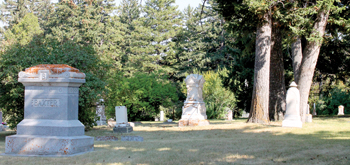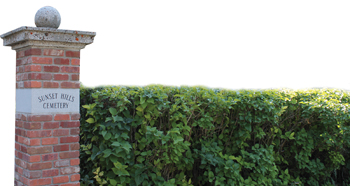Sunset Hills Cemetery
 Established on a rise east of the commercial district in 1872, Sunset Hills Cemetery is the final resting place of many Bozeman history-makers. The gravestones found on the cemetery grounds communicate the life of the deceased in narrative engraved text as well as the more subtle shapes and symbols incorporated into the marker’s design. Trees, fences, shrubbery and other landscape elements further define the community’s commitment to honoring deceased friends and family.
Established on a rise east of the commercial district in 1872, Sunset Hills Cemetery is the final resting place of many Bozeman history-makers. The gravestones found on the cemetery grounds communicate the life of the deceased in narrative engraved text as well as the more subtle shapes and symbols incorporated into the marker’s design. Trees, fences, shrubbery and other landscape elements further define the community’s commitment to honoring deceased friends and family.
The death in Bozeman of Mary Blackmore, wife of a British industrialist who participated in an 1872 scientific expedition into Yellowstone Park, lead to the creation of Sunset Hills Cemetery. Blackmore’s husband purchased the cemetery’s original five acres from the Daniel Rouse family and presented the property to the community for use as a burial ground. Blackmore’s black granite triangular monument mimics the shape of the over 10,000 foot high peak in the Gallatin Mountain Range to the south of Bozeman, also named in Mary Blackmore’s honor.
Text engraved on a memorial marker usually included the dates of birth and death, sometimes detailing the age of the deceased down to year, month and days of life. As western settlement after the Civil War drew people from across the United States, notation of the deceased’s place of birth became a common inclusion on headstones. Additional engraving often expanded on the departed’s personal attributes, family ties or participation in the community. For example, the markers for participants in the “Grand Army of the Republic,” a fraternal organization for Union veterans of the Civil War, usually incorporated the deceased’s final rank, unit of service and “G. A. R.”
As monuments to the deceased, gravestones of the 19th and early 20th century often communicated the person’s life in engraved visual symbols like the shape of the monument itself or engravings on the marker. A tombstone shaped like a vertical obelisk, or engraved with the symbols of the all-seeing eye or square and compass denoted the burial location of a member of a Masonic organization. Like many fraternal organizations in this time period, the Masons flourished in the West and included Bozeman founders John Bozeman, Daniel Rouse, William Beall and William Tracy.
Sunset Hills Cemetery includes a handful of unusual tombstones carved to appear as tree stumps, which were intended to symbolize a life cut short. More elaborate versions visually represented the tragedy of the person’s death. Twisted branches correlated to the number of children left orphaned. A double tree stump monument, often with the roots of the trees intertwined marked the final resting place for two people whose lives had become one. Plants engraved on tree stump markers often represented the person’s belief in an eternal life; English ivy, which stays green through the winter, symbolized life after death.
Some family burial plots incorporate a larger monument with the familial surname, surrounded by smaller markers for individual family members. The Story family plot, on the east side of the cemetery, is one example. Nelson Story and wife Ellen Trent Story arrived in Virginia City from Ohio in 1863, just as the gold mining camp began to boom. Story used the $30,000 in gold dust panned from Alder Creek to purchase longhorn cattle in Texas, which he drove to Montana effectively founding the state’s cattle industry. This portion of his life is the basis for the character “Captain Call” in Larry McMurtry’s novel Loneseome Dove.
Story’s financial success included investments in flour milling operations, banking and real estate. Wealth could not prevent heartache, and Nelson and Ellen’s monuments are surrounded by a handful of memorials to deceased children, which reflect the tragically high childhood mortality rate of the 19th century. A number of gravestones for children, often incorporating symbols of innocence like lambs and flowers, are found in Sunset Hills Cemetery.
Flanking the Story family plot is a set of granite columns and balustrade from the porch of the Nelson Story mansion, which once stood on the 400 block of West Main Street in Bozeman. Constructed in 1886, the impressive residence was dismantled in 1937 to make room for Willson School. The architectural elements were moved to Sunset Hills to further enhance the Story plot.
Over time a number of gravestones have been lost to weather and vandalism. In fact, cattle grazing on the property through the 1880’s damaged many of the headstones beyond repair and original portion of the cemetery includes over 500 unmarked graves. Fencing erected around the edges of the property at the turn of the 20th century kept range stock out and further defined the property. In 1910 Elizabeth Bogert founded the Cemetery Board, which planted spruce and birch trees and a number of other plants not native to Montana, further enhancing the created landscape.
Also unmarked are a number of burial plots for the County Poor Farm, located in the north west corner of the property. Chinese graves which reflect Montana’s diverse population during the settlement period, were also located in the north west portion of the cemetery. Many of the Chinese burials were repatriated to China by relatives, who desired to bury their ancestors in their home province.
This article is a small insight into the history and symbolism of Bozeman’s Sunset Hills Cemetery. The Bozeman Historic Preservation Advisory Board will host a guided walking tour of Sunset Hills Cemetery on Saturday, October 20, 2012. The public is invited to attend this free event, which begins at 9 am with a short lecture about the rural cemetery movement in the small meeting room of the Bozeman Public Library at 625 East Main Street. Shortly thereafter, a guided walking tour of the cemetery will begin at the cemetery gates on Buttonwood Drive. More information about the event can be found on the Preservation Board’s website: www.preservebozeman.org
Courtney Kramer is a proud graduate of MSU’s History Department and serves as the City of Bozeman’s Historic Preservation Officer. She may be contacted at the City Planning Office, 406-582-2260 or via email at ckramer@bozeman.net. More information about Bozeman’s historic districts is available at www.preservebozeman.org